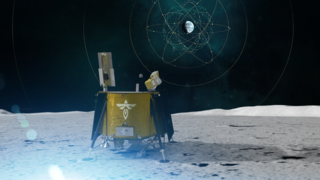
Audience
Educators, Students
Grade Levels
Grades 5-8, Grades 9-12, Informal Education
Subject
Art, Human Space Exploration, Space Science, Spanish, Technology, Present and Future, Missions to Planets and Moons, Communication
NASA is going to the Moon to learn how to eventually live on Mars! Through the Artemis missions, NASA will land the first woman and first person of color on the Moon. Along with their fellow astronauts, they will explore the Moon’s South Pole and learn to live and work around the Moon.
Throughout their journey, NASA astronauts and spacecraft must communicate with mission control on Earth. NASA’s Space Communications and Navigation (SCaN) program operates the Deep Space Network and Near Space Network to ensure explorers can always call home. These networks also enable missions to send back important science information – like pictures and videos. NASA currently uses radio waves to communicate information to and from spacecraft, but the agency is testing the use of invisible laser light to send more data at once. NASA is also creating LunaNet, an “internet” on the Moon that will allow explorers and spacecraft to easily communicate with each other and Earth. This will be similar to what humans experience on Earth.
Using the downloadable pages, illustrate the adventures of NASA’s Artemis astronauts by creating a comic. Students can submit scans of their comic which could be featured on NASA’s social media
How to Show Us Your #NASAMoonSnap:
There are three social media platforms that you can use to submit your work.
- Instagram: Use the Instagram app to upload your photo or video, and in the description include #NASAMoonSnap or tag @NASAArtemis in your stories
- Twitter: Share your image on Twitter and include #NASAMoonSnap in the tweet
- Facebook: Share your image on Facebook and include #NASAMoonSnap in the post
We will be sharing a variety of Moon Snaps on our social media accounts, on our website, and during the Artemis I launch broadcast!
Link to resource:



























